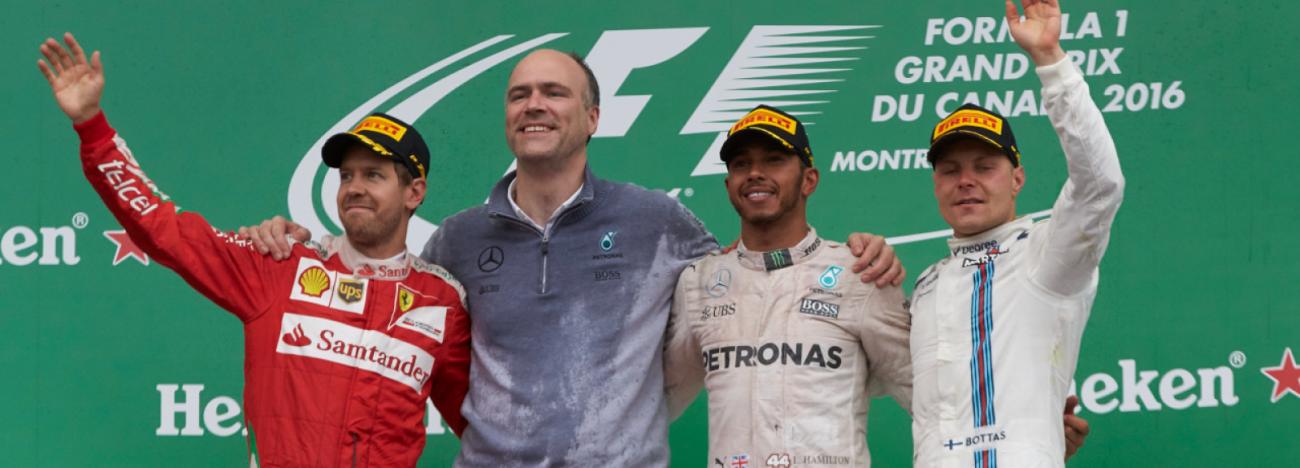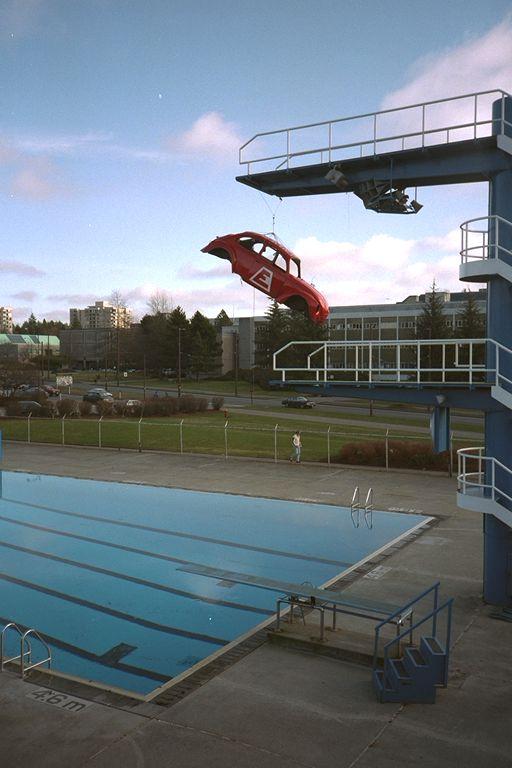On the Fast Track
At first glance, Formula 1 racing may not resemble a team sport. Like tennis players and track sprinters, race-car drivers are alone on the field of play, pushing their bodies and minds to the limit, embracing victory or suffering defeat as lone public figures when they cross -- or fail to cross -- that finish line.
But there is a unique character to Formula 1 that elevates the car itself to the level of teammate. Or hundreds of teammates, if you count all the designers, builders, mechanics, and engineers it typically takes to maintain a state-of-the-art race car.
As head of Trackside Electronics for Mercedes-AMG Petronas Motorsport, Evan Short, BASc’98, is part of an 800-member team responsible for Mercedes’ pair of Formula 1 race cars, which have dominated the sport for the past four years, winning every world championship since 2014.
That’s 800 world champions -- 802 if you count the drivers -- working year-round to win a series of 20 Grand Prix races, an entire season that can be decided by milliseconds. For Short, those milliseconds have piled one upon the next into a two-decade blur of impossible victories, humiliating setbacks, and endless, endless travel.
“My whole career I’ve been travelling,” he says. “It’s a busy sport. It hops from race to race and country to country. Some people really enjoy that -- every week you’re in a new country, you’ve got a new challenge. Some people hate it, because you see a lot of airports and racetracks and airports and racetracks. But it fits me pretty well.”
It’s a far cry from the one trip a year Short had to make while an undergraduate at UBC. Working as an electrical engineer with Formula UBC -- a team of students that builds a new formula-style racer every year for an annual collegiate design competition in Detroit -- Short spent many nights and weekends in a garage or on a local track with only the faintest glimmer of what his future would hold.
“It took a big bite out of my schoolwork, but it was so much more valuable than just the classrooms,” he recalls. “Being able to actually do things, to weld frames together, to design things and see things you designed break -- it’s so valuable. You don’t learn it on paper, you learn it by designing it and building it and watching it fail horribly and fall off the car. It’s great fun.”
At the time, there were few electronics in student race cars. Short’s wizardry with wires and circuits got him noticed at the Detroit track by an Italian racing engineer who encouraged him to pursue a career in Formula 1, ultimately recommending him for a position with Ferrari. Only a year after graduating, Short and his girlfriend -- a UBC mechanical engineer who would become his wife -- found themselves in Monte Carlo working for the Ferrari team, an experience he can only describe as “surreal.”
Over the next decade, Short would carve out an enviable career for himself as a radio engineer, instrument designer, systems engineer, and controls engineer, winning five consecutive world championships running electronics for Michael Schumacher, the top ranked driver in the history of the sport.
In 2008, Short and his wife moved to England and began a family, with Short going to work for a UK team that would eventually be bought by Mercedes. Placing Lewis Hamilton behind the wheel, Mercedes has won four consecutive series since 2014, elevating Short’s own record to 12 world championships over his 20-year career. The team’s 2017 season was one for the books -- 12 wins, 26 turns at the podium, the fastest pit stop award, and the Constructor’s Crown (in a nutshell, the best-built car on the track).
As thrilling as it is to win it all at the end of the year -- an outcome determined by the total number of points accumulated throughout the season -- nothing beats the highs and lows of being in the moment.
“We’ve had incredible races where we started with a car that we didn’t expect to win, then ended up with a 1-2, where one driver ends up in first and the other driver in second,” says Short. “But we had one weekend a couple of years ago where our drivers collided in the first corner and knocked each other out of the race. The whole week’s worth of work was gone in the first 10 seconds.”
The level of information they get from the car during a race is staggering. Hundreds of gigabytes of data are filtered through thousands of closely monitored channels.
With 802 people on the team, anyone can make a mistake, and any mistake can have disastrous consequences. Short remembers his own lowest moment, watching a gearbox explode in the middle of a critical qualifying lap when he was with Ferrari.
“I made a mistake in programming the gearbox,” he recalls. “A one-number error. I literally just typed in an extra zero in one of the hundreds of numbers I was putting in and blew up the gearbox. The whole team was looking around to try and work out what went wrong, and I had that sinking feeling where you think, Oh...I know what went wrong.”
Such is the drama in a game of milliseconds and macro-equations, red-eye flights and crowded garages. Short runs a small team of 7-9 engineers within a larger group of 60 people who travel to all the races. Each engineer has a very specific job -- calibration specialists, electricians who handle the physical wiring, and controls engineers who fine-tune the hydraulic systems, the gearshift, the differential, the driver interface, and the steering wheel.
The level of information they get from the car during a race is staggering. Hundreds of gigabytes of data are filtered through thousands of closely monitored channels. The engineers watch for every minute detail -- suspension loads, hydraulic systems, the power unit, the hybrid power system, the battery elements – information they communicate to the driver, who has to make adjustments on the fly while rounding corners at nearly 300 kilometers per hour.
But the 40 hours of actual track time -- 20 races a season at two hours each -- barely scratch the surface of what really goes into a Grand Prix. For a Formula 1 team, race day starts the week before. Mechanics fly out to the track as early as Monday to build the garage and receive the 40 tons of freight that make up their workspace. The race crew arrives on Wednesday to put together the cars, which are largely rebuilt after each run and sometimes sent back to the factory in England when there is enough time between races. The engineers arrive on Thursday to fine-tune the cars for Friday practice sessions at the track, which is followed by a long night of rebuilding the car again for Saturday’s practice and the qualifying runs that determine pole position for the big event.
These lead-up days can last up to 18 hours as the crew performs an intimate choreography of detailed prep, culminating in a Sunday morning spent analyzing, strategizing, and focusing on each specific task as the clock ticks closer to the 2pm start flag. And once the race is over, the cycle begins again. Sixty people spend their Sunday night in a garage breaking the cars down to their bolts, sealing the parts in custom-made containers, and forklifting every last bit and tons of support material onto a fleet of trucks or 747s, depending on the distance to the next Grand Prix. Races outside of Europe see teams bouncing between Kuala Lumpur, Shanghai, Sao Paulo, Montreal, Abu Dhabi, and Melbourne. Over the course of a season, a team will travel the equivalent of four times around the globe.
“There’s maybe 15,000 parts on a car, and we know exactly how many kilometers each part on the car has covered,” says Short. “So you know a particular wheel nut will have done 50 pit stop cycles, or a particular suspension element will have done 350 kilometers.”
“You have to keep moving just to stand still. If you have the fastest car at the beginning of the season and don’t develop it at all, you will absolutely be mid-field by the end of the season.”
The mechanics and engineers walk a fine line making sure every part is reliable -- building a car that doesn’t break down when it’s being driven to the absolute limit is critical -- but if the car is sturdier than necessary, it will be too heavy to win. “In order to finish first, you must first finish,” says Short. “But you don’t want a big heavy monster of a car. The ideal F1 car is designed so that it finishes the race, and just after the line it falls apart.”
The greatest challenge, from an engineering perspective, is rebuilding the cars in between the races. Only the carbon fibre survival structure remains intact, while the bodywork, aerodynamics, and suspension all develop race to race, so the cars get faster as the season progresses. “You have to keep moving just to stand still,” Short says. “If you have the fastest car at the beginning of the season and don’t develop it at all, you will absolutely be mid-field by the end of the season.”
In between seasons, the design rules change -- hence the name Formula 1, referring to the formula that makes up each year’s design regulations. Cars must conform to a strict set of rules that cover everything from weight limit to fuel capacity to restrictions on material. Engineers spend the off-season working at the constructor factories west of London, redesigning the cars for the coming year.
These few off-season months -- from December to March -- are the only times Short catches a whiff of a regular 9-5 job and gets to drive his own car, a 1972 Fiat 500. “It’s like the lowest tech car in the world,” he says. “I drive that because I spend my whole day working on incredibly complicated electrical systems, and the Fiat has almost no electronics. There isn’t a single transistor on it. The only electrical systems are the spark plugs and the headlights. You can fix it with a coathanger.”
These winter breaks also give him time with his three children and his wife, who has taken up a new career as a breastfeeding counsellor. But once the racing season rolls around again in March, it’s back to airports and racetracks and airports and racetracks. “It’s very high stress, it’s very dynamic, it’s hard work, but it is great fun,” says Short. “We’re going out and playing like little kids with the most expensive toys in the world.”


































